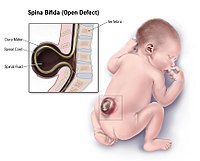
Photo from wikipedia
OBJECTIVES To assess the effect of sacral neuromodulation (SNM) in ambulatory spina bifida patients with neurogenic bladder and bowel dysfunction. MATERIALS AND METHODS We retrospectively reviewed the records of 29… Click to show full abstract
OBJECTIVES To assess the effect of sacral neuromodulation (SNM) in ambulatory spina bifida patients with neurogenic bladder and bowel dysfunction. MATERIALS AND METHODS We retrospectively reviewed the records of 29 ambulatory spina bifida patients with neurogenic bladder and bowel dysfunction who underwent SNM testing from July 2012 to January 2020. Clinical data and video-urodynamic parameters were collected and compared using the t-test and the chi-square test. The potential risk factors were considered by logistic regression analysis. P < 0.05 was considered significant. RESULTS In the test phase, twenty-one patients (72.4%) achieved successful improvement of at least one symptom. The success rate for chronic urinary retention (26.09%) was significantly lower (p<0.05) than that for urgency-frequency syndrome (58.82%) and urinary incontinence (56.25%). The mean neurogenic bowel dysfunction score decreased from 13.3±6.29 to 6.9±5.09 (P<0.0001). The urodynamic evaluation showed a significant improvement in the mean maximum cystometric capacity, compliance, and maximum detrusor pressure (p<0.05). Implantation was performed in 16 cases (55.17%). The analysis of the risk factors showed that chronic urinary retention was a statistically significant variable (p<0.05). No complications were reported in the test phase. The average follow-up time was 41.19±33.06 months. Two patients changed to intermittent catheterization, and two patients changed to augmentation cystoplasty. CONCLUSIONS SNM is effective for neurogenic bladder and bowel dysfunction in patients with ambulatory spina bifida, especially in those without chronic urinary retention. And SNM can also significantly improve the urodynamic parameters of these patients during the storage period.
Journal Title: Urology
Year Published: 2021
Link to full text (if available)
Share on Social Media: Sign Up to like & get
recommendations!